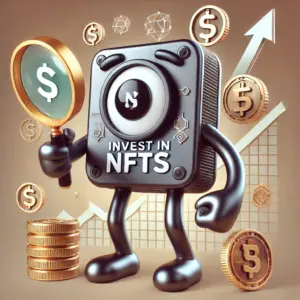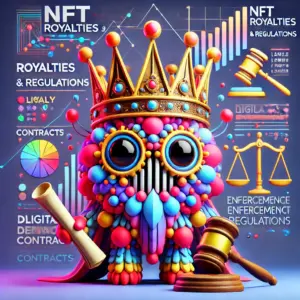The advent of blockchain technology has ushered in a new era of digital assets, with two prominent players taking center stage: NFTs (non-fungible tokens) and cryptocurrencies like Bitcoin. While they share some similarities, these two entities are distinct in their fundamental characteristics and applications.
NFTs: A Unique Digital Identity
NFTs, as the name suggests, are unique digital identifiers assigned to specific assets. These assets can be anything from digital artwork to in-game items, collectibles, or even real-world assets like property titles. Each NFT holds a unique cryptographic code that distinguishes it from any other NFT, making it an indivisible unit. This immutability and uniqueness are ensured by the underlying blockchain technology, which maintains a transparent and tamper-proof record of ownership.
Bitcoin: A Digital Currency
In contrast to NFTs, cryptocurrencies like Bitcoin are fungible, meaning they can be exchanged one for another without any loss of value or uniqueness. Each Bitcoin is equal in worth to every other Bitcoin, just like one dollar bill is equal to another dollar bill. This uniformity stems from the fact that Bitcoin is a digital currency, designed to serve as a medium of exchange and store of value.
Key Differences: Fungibility and Functionality
The core difference between NFTs and Bitcoin lies in their fungibility. NFTs are irreplaceable, while Bitcoin is interchangeable. This distinction has profound implications for their functionality and applications.
NFTs excel at representing unique digital assets, providing a secure and verifiable way to prove ownership. They are particularly useful for digital art, collectibles, and other assets where scarcity and authenticity matter. Their uniqueness also opens up new avenues for digital scarcity-based applications, such as access control and loyalty programs.
Bitcoin, on the other hand, thrives as a digital currency, facilitating peer-to-peer transactions without the need for intermediaries. Its decentralized nature and immutability make it an attractive option for individuals seeking alternative payment systems and those who value censorship resistance.
A Tale of Two Assets
NFTs and Bitcoin are both transformative technologies with distinct applications. NFTs empower creators to secure ownership and monetization of their digital assets, while Bitcoin revolutionizes the way we exchange value and interact with the financial system. While they may not be directly interchangeable, both play crucial roles in shaping the future of digital ownership and commerce.
NFTs and Bitcoin: Commonalities and Misconceptions
Despite their fundamental differences, NFTs and Bitcoin share some commonalities that often lead to confusion and misconceptions among the general public. Let’s delve into these shared characteristics and address the common myths surrounding these two digital assets.
Shared Blockchain Infrastructure:
NFTs and Bitcoin are both built on blockchain technology, a distributed ledger system that records transactions and ensures data immutability. This shared infrastructure provides a foundation for their secure and transparent operations.
Cryptoeconomic Incentives:
Both NFTs and Bitcoin employ cryptoeconomic incentives to encourage participation and maintain the integrity of their respective networks. For NFTs, these incentives often take the form of royalties for creators, while Bitcoin rewards miners for verifying transactions.
Digital Ownership and Scarcity:
Both NFTs and Bitcoin address the concept of digital ownership and scarcity. NFTs provide a verifiable way to prove ownership of unique digital assets, while Bitcoin’s limited supply limits the number of coins in circulation.
Misconceptions and Misinterpretations
Despite these shared characteristics, several misconceptions and misinterpretations often blur the lines between NFTs and Bitcoin. Let’s address some of the most common myths:
Myth 1: NFTs are Just Digital Collectibles:
While NFTs are often associated with digital art and collectibles, their potential extends far beyond these domains. NFTs can represent a wide range of assets, including in-game items, tickets, real-world assets, and even intellectual property.
Myth 2: NFTs are a Ponzi Scheme:
The rapid growth and high valuations of some NFT projects have fueled concerns about their potential for scams and manipulation. However, it’s essential to distinguish between legitimate NFT projects with strong fundamentals and those that rely on hype and speculation.
Myth 3: NFTs Replace Cryptocurrency:
NFTs and cryptocurrencies serve distinct purposes. NFTs provide a way to represent ownership of unique digital assets, while cryptocurrencies are designed as mediums of exchange and stores of value.
Myth 4: Bitcoin is Not a Real Asset:
Bitcoin, like any other asset, has its own value proposition and risk profile. Its decentralized nature, limited supply, and potential for widespread adoption make it an attractive asset for many investors.
Navigating the Digital Asset Landscape
The emergence of NFTs and Bitcoin has introduced a new dimension to the digital landscape, blurring the lines between traditional assets and intangible digital creations. Understanding the nuances of these technologies is crucial for navigating this evolving ecosystem and making informed investment decisions.
As NFTs and Bitcoin continue to mature, their applications and integrations are expected to expand, potentially revolutionizing the way we interact with digital content, assets, and services. The key lies in recognizing their unique strengths and exploring the possibilities for their synergistic coexistence.
Conclusion: Unveiling the Synergy
Despite their differences, NFTs and Bitcoin can coexist and complement each other. NFTs can leverage the transactional power of Bitcoin, enabling seamless trade and exchange of unique digital assets. Bitcoin, in turn, can benefit from NFTs’ ability to represent and authenticate digital assets, potentially expanding its utility beyond pure currency transactions.
The future of blockchain technology holds exciting possibilities for both NFTs and Bitcoin. As these technologies mature and gain wider adoption, we can expect to see innovative applications and cross-pollination of their functionalities, shaping a more dynamic and interconnected digital ecosystem.






